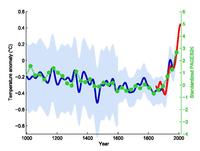
Photo from wikipedia
Abstract Classical logarithmic linearization of the single backscattering model to estimate the coda Q ( $$ Q_{c} ) $$ Q c ) leads to biased results in the presence of… Click to show full abstract
Abstract Classical logarithmic linearization of the single backscattering model to estimate the coda Q ( $$ Q_{c} ) $$ Q c ) leads to biased results in the presence of low signal-to-noise ratio. Non-linear regression using the Levenberg–Marquardt (L–M) method has been proposed to estimate the $$ Q_{c} $$ Q c in the frequency range of 3–24 Hz on local earthquakes recorded in northeast region of India. Results of both classical log-linear and non-linear approaches to the single backscattering model are compared. On datasets with good signal-to-noise ratio both the approaches lead to almost the same results. However, for datasets having low signal-to-noise ratio, we found that the log-linear technique estimates are biased. Results demonstrate that the log-linear approach overestimates the $$ Q_{c} $$ Q c in comparison to the non-linear approach. Frequency dependence parameter ‘ $$ \eta $$ η ’ for the L–M method is slightly higher than the conventional log-linear approach. The $$ Q_{c} $$ Q c variation with lapse-time is also studied with both the approaches. The biased results of log-linear approach were observed at different frequencies at all lapse times. Significantly lower $$ Q_{0} $$ Q 0 (1 Hz) estimates of non-linear approach indicated more heterogeneous lithosphere than the log-linear approach. Highlights A novel approach to the single scattering model is proposed wherein nonlinear regression is performed to estimate coda Q c . Coda attenuation and its variation with lapse time is analysed (3–24 Hz) from local earthquakes of North East India For datasets having a low signal-to-noise ratio the estimates of the conventional log-linear regression were biased. Significantly lower Q 0 estimates of the non-linear approach indicated a more heterogeneous lithosphere than a log-linear approach.
Journal Title: Journal of Earth System Science
Year Published: 2020
Link to full text (if available)
Share on Social Media: Sign Up to like & get
recommendations!